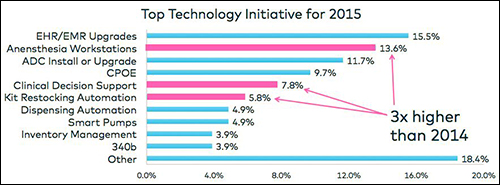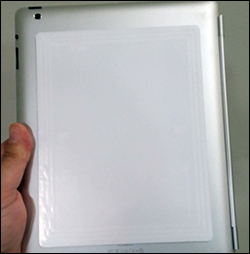The following are news announcements made during the past week by the following organizations:
Gimbal;
EnvisionWare;
Precision Dynamics Corp.;
Sandia National Laboratories; and
Kit Check.
Gimbal Expands Product Line With New USB-Powered Bluetooth Beacons
Gimbal has announced the availability of its Bluetooth Smart Gimbal Proximity Beacon U-Series 5. According to the company, the new beacon is a low-cost, low-maintenance solution that adds beacon functionality to traditional devices with USB ports, including computers, televisions, set-top-boxes, kiosks, point-of-sale (POS) terminals, vending machines, automated dispensers and more.
Gimbal’s Bluetooth-enabled beacon platform, which includes Bluetooth Smart beacons, as well as software, is context-aware and offers geofencing, proximity and interest sensing, consumer privacy controls, a communication platform and other features. It is designed to deliver targeted, real-time location data to trigger message campaigns to beacon-enabled smartphone apps, based on a user’s arrival, departure and dwell times from custom-geofenced areas.
The U-Series 5 beacon is Gimbal’s smallest proximity beacon to date, measuring 0.76 inch long, 0.61 inch wide and 0.28 inch high (19.3 millimeters by 15.6 millimeters by 7.1 millimeters). It is designed to enable a variety of devices to power proximity-triggered engagements to an opted-in user’s mobile device, and helps retailers, venues and other beacon-enabled locations further extend their proximity networks. For added security, the U-Series 5 does not have USB data lines connected, which means it can safely be plugged into a powered USB port in a computer, POS register, ATM or other device with no risk of sending or receiving any data.
Gimbal Proximity Beacon U-Series 5 are available now for $25 apiece at https://store.gimbal.com.
EnvisionWare Launches RFID Tablet Tag
EnvisionWare, a provider of self-service and library efficiency solutions, has announced its Tablet Tag for libraries. The high-frequency (HF) 13.56 MHz passive RFID tag is designed to help libraries manage the loaning of mobile devices, including Apple iPads, Android devices and other tablets, as well as e-readers.
The Tablet Tag works like a traditional RFID tag used in books and other print materials, and can be utilized for both security and circulation. According to EnvisionWare, the performance is comparable to that of its standard RFID book tag. The RFID Tablet Tag has undergone testing on multiple tablet brands, as well as laptops and MacBooks, says Mike Monk, EnvisionWare’s co-founder and CEO. “Our company designs products for libraries, and therefore we test according to library standards,” he explains. “The Tablet Tag demonstrates detection performance through our UltraTransparent Series RFID gates generally equivalent to that of a book tag.”
The Tablet Tag, made with NXP Semiconductors‘ iCode SLIx chip, supports the ISO 15693 specification. It features 1024 bits of memory, contains a ferrite layer and a white semi-gloss paper face, Monk reports, and uses an aggressive acrylic adhesive. The largest Tablet Tag measures 144 millimeters by186 millimeters (5.7 inches by 7.3 inches); smaller sizes are available for the iPad mini and similarly sized tablets.
The Tablet Tag (RFID-TAG-BU TABLET07) is supplied in single-lot quantities at a price of $24 per tag.
Camelback Resort’s Lodge and Aquatopia Waterpark Adopt PDC’s RFID Wristband System
Precision Dynamics Corp. (PDC) has announced that Camelback Resort‘s lodge and Aquatopia Indoor Waterpark, in the Pocono Mountains, are using PDC’s Smart Band RFID Wristband System for access control, cashless purchasing and locker rentals. PDC’s Smart Bands have 13.56 MHz passive RFID tags embedded in them that each feature a unique code to verify guest data when scanned by readers at doors, turnstiles and point-of-sale stations.

Upon checking in at the Camelback Lodge, guests are provided with the waterproof, non-transferable Smart Band RFID wristbands instead of room keys that they can then use to enter their hotel suites and the waterpark during the duration of their stay. The wristbands feature a one-time snap closure that secures it to a patron’s wrist, PDC reports, so unlike a key card or cash, it will not become misplaced or lost on water attractions.
In addition, guests can use their wristbands to make instant, cashless payments that post directly to their hotel room folios—a feature that can increase purchases, PDC says. “Guests may pass up on smaller purchases like ice cream if their cash or credit cards are not readily available,” said Robin Barber, PDC’s VP of leisure and entertainment, in a prepared statement. “But with Smart Band, guests have the freedom to make any purchase with a quick swipe of their wrist. This allows them to spend more time enjoying the resort’s amenities instead of walking to and from their locker or room.”
“We saw first-hand how PDC’s Smart Band RFID Wristband System has benefited similar properties and wanted to create an enhanced guest experience that our patrons would remember us by,” says Pete Helland Jr., a co-owner of Camelback Resort and a managing partner at Stand Rock Hospitality, which operates Camelback. “Smart Band also enhances productivity by park employees by making transactions extremely quick and simple. Plus, since Smart Band has been fully customized to reflect our branding, every guest’s wrist is now an advertisement for us wherever they go.”
Smart Band is available in a wide variety of colors, closure options and materials, according to PDC, including plastic, silicone and woven fabric. The wristband can be entirely customized, the company reports, and is offered in both non-transferable and re-wearable styles, optimal for single-day or season pass applications.
Sandia National Lab Solicits Partners to Commercialize ‘Active Authentication’ Technology
The U.S. Department of Energy‘s Sandia National Laboratories has announced that it is looking for industrial partners to develop applications using “active authentication technologies” to help protect data transfers via smartphones, home appliances and smart meters, and point-of-sale systems, as well as protect drones and ensure that drone commands remain unspoofable.
Sandia National Laboratories, part of the Energy Department’s National Nuclear Security Administration, is managed by Lockheed Martin‘s Sandia Corp. subsidiary. The solicitation references Sandia’s authentication technology, which is designed to provide digital security via “Quasi-Physically Unclonable Digital Identification.”
Sandia’s technology differs from another commercially available authentication technology known as physically unclonable functions (PUFs), which can be used to create encryption keys, generate random numbers or authenticate devices. PUFs help to protect individual chips from data theft, and make them difficult to clone by using the unique “fingerprint” inherent in every semiconductor device to protect its encryption key (see RFID News Roundup: NXP Strengthens SmartMX2 Security Chips With PUF Anti-cloning Technology and Verayo, Bartronics Unveil Unclonable Solution for Indian ID Market). According to the Sandia solicitation, PUFs in digital IDs have been explored by many research institutions in an attempt to increase security. While the concept of PUFs shows promise, current implementations are inherently problematic: they have inconsistent behavior, and are expensive, susceptible to modeling attacks and permanent.
To overcome those challenges, Sandia’s Quasi-Physically Unclonable Digital Identification scheme creates an unclonable, dynamic digital identity for use between two communication endpoints, such as mobile devices. This technology relies on an “unreplicable data scrambling physical medium” at one end of a transfer and, later, a “corresponding device specific descrambler/software to authenticate the device,” according to the solicitation. It also combines a unique device identity with a dynamic human identity, the solicitation indicated, thereby creating a true two-factor authentication.
In its solicitation, Sandia said it seeks to transfer technology for the benefit of the United States’ private sector. Qualified partners will contribute resources including funds-in support and in-kind support in the form of laboratory staff and instrumentation. Partners will have the option of obtaining up to and including an exclusive license to Sandia’s intellectual property, in the form of a Cooperative Research and Development Agreement (CRADA)—a legal document that permits the transfer of Sandia National Laboratories’ technologies, processes, research and development capabilities, and technical know-how to U.S. companies and organizations.
Sandia will evaluate responses (the submission deadline is Sept. 26) and select prospective parties and requests from prospects that have cryptographic module or hardware experience and a background knowledge of authentication. A minimum funds-in investment of $500,000 is required, according to the solicitation. More information is available at the FedBizOpps website.
More Pharmacies Seek Automated Kit-Stocking Technologies, New Study Finds
Hospital pharmacy directors identified their most manual processes and, among the several emerging technologies to help, cited the use of technology to automate the pharmaceutical kit-stocking process, according to a recent report published by Kit Check, a provider of RFID-based solutions for automating hospital pharmacy kit processing and medication tracking.

Kit Check surveyed pharmacy directors at more than 800 U.S. hospitals during a three-week period in April and May 2015. According to the resulting report, “Hospital Pharmacy Operations Report 2015, The State of Hospital Pharmacy Operations,” pharmacists’ top five most manual processes were IV prep, pharmacy kit restocking (both code cart and anesthesia trays), unit dose prep, cart fill and delivery and inventory management. As for the top technology initiatives reported by respondents, kit-restocking automation was too small to highlight in 2014. This year, however, kit-restocking automation came in sixth, with 5.8 percent of responses (a percentage three times higher than in 2014).
“Pharmacy kit automation improves the restocking process,” the survey said, “and it also helps pharmacy managers proactively manage expiring medications, identify the location of recalled items and determine optimal kit par levels based on actual usage.”
Other technology initiatives included electronic health records or electronic medical records upgrades (15.5 percent of responses), anesthesia workstations (13.6 percent), automated data-collection installs or upgrades (11.7 percent), computerized physician order entry (CPOE) systems (9.7 percent) and clinical decision support systems (7.8 percent).
Kit Check’s solutions use RFID to automatically record a pharmacy kit’s serial number, create a detailed audit trail and identify each individual medication within the pharmacy kit. Trays in which the medications are stored are also RFID-tagged, the company reports, so they can be automatically tracked and inventoried.


